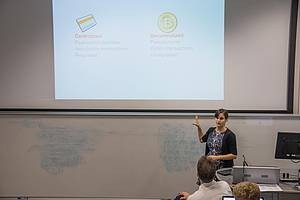Nicolas Courtois, a mathematician and senior lecturer in computer science at UCL, working with Daniel Hulme and Theodosis Mourouzis, has won the 2012 best paper award from the International Academy, Research, and Industry Association for their work on using SAT solvers to study various problems in algebra and circuit optimization. The research was funded by the European Commission under the FP7 project number 242497, “Resilient Infrastructure and Building Security (RIBS)” and by the UK Technology Strategy Board under project 9626-58525. The paper, Multiplicative Complexity and Solving Generalized Brent Equations with SAT Solvers, was presented at Computation Tools 2012, the third International Conference on Computational Logics, Algebras, Programming, Tools, and Benchmarking, held in Nice, France in July.
https://www.youtube.com/watch?v=Lfen7ZOIkYw
SAT (short for “satisfiability”) solvers are algorithms used to analyse logical problems composed of multiple statements such as “A is true OR not-B is true or C is true” for the purpose of determining whether the whole system can be true – that is, whether all the statements it’s composed of can be satisfied. SAT solvers also are used to determine how to assign the variables to make the set of statements true. In 2007, Bard and Courtois realised they could be used to test the security of cryptographic functions and measure their complexity, and today they are important tools in cryptanalysis; they have already been used for a long time in other applications such as verifying hardware and software. In this particular paper, Courtois, Hulme, and Mourouzis focused on optimising S-boxes for industrial block ciphers; the paper reports the results of applying their methodology to the PRESENT and GOST block ciphers. Reducing the complexity and hardware cost of these ciphers is particularly important to build so-called secure implementations of cryptography. These are particularly costly because they need to protect against additional threats such as side-channel attacks, in which the attacker exploits additional information leaked from the physical system – for example, by using an oscilloscope to observe a smart card’s behaviour.
“It’s more a discovery than an invention,” says Courtois. “One of the amazing things SAT solvers can do is give you proof that something is not true.” The semiconductor industry provides one application of the work in this paper: these techniques promise to provide a way to test whether a circuit has been built with the greatest possible efficiency by proving that the chip design uses the smallest possible number of logic gates.
“You’ll get optimal designs and be able to prove they cannot be done better,” he says.
Classical cryptanalysis proceeds by finding approximations to the way a cipher works. Many successful academic attacks have been mounted using such techniques, but they rely on having a relatively large amount of data available for study. That works for large archives of stored data – such as, for example, the communications stored and kept by the Allies after World War II for later cryptanalysis. But in many real-world applications, it is more common to have only very small amounts of data.
“The more realistic scenario is that you’ll just have one or a few messages,” says Courtois. Bluetooth, for example, encrypts only 1,500 bits with a single key. “Most attacks are useless because they won’t work with this quantity of data.” Algebraic cryptanalysis, which he explained in New Frontier in Symmetric Cryptanalysis, an invited talk at Indocrypt 2008, by contrast, is one of the few techniques that can be hoped to work in such difficult situations.
 As a child,
As a child, 